The barren African landscape, darted far more frequently by sharp rocks marking cliff edges on a one-and-a-half-lane-wide road than people or animals, may, on the surface, be a weird place to see the future of Defender. But, if you followed the dust of the convoy of 2025 Defender OCTAs a few weeks ago, you'd plainly see the direction the brand is headed.
Great Defender off-roading expeditions have their roots in Africa. Teams from Oxford and Cambridge, England traversed the continent in the mid-1900s making the 11,000-mile round trip more than once.
Camel Trophy competition expeditions, nicknamed the "Olympics of 4x4," were annual exercises from 1980-1998 that pitted Defenders against some of the toughest terrain the world offers, from Asia to Africa to South America. The competition ended because, at the time, Land Rover, the Defender brand's parent company, was moving away from extreme off-roading, focusing on the Discovery and Range Rover lineups instead.
Today, Defender is charging forward with its future. Now five years into a relaunch of the brand's models, the company has its eyes set on reclaiming its past gravitas. Nestled comfortably between heritage, lineage and modernity, the brand is rising to the occasion.
Its latest offering is Defender OCTA, the boldest, most powerful and most expensive version of its four-door sport utility vehicle (SUV). It's been certified for top performance on the road and on the track - usually it's one or the other.

Defender OCTA is all about performance. If you think the usual 110 is good, this is far, far better.
Its OCTA drive mode is made for high-speed off-roading, the kind that also makes the Ford Bronco Raptor shine. On slippery, loose gravel, Defender's OCTA drive mode allows a driver to go faster, brake harder, and push the SUV to its limits. It's unnervingly sophisticated in its delivery, something Bronco Raptor is not.
An active air suspension allows OCTA to raise and lower on command, going up a few inches in off-road mode helps the Defender to take on desert dips at higher speed than a driver would normally be comfortable at. While driving it on a closed course, I was almost sure that I would destroy the expensive SUV by hitting the sizable divot ahead at the 45 kilometers per hour that the driving pro sitting next to me recommended. Instead, the result was a disarmingly smooth jolt and recovery, then back on the gas for higher-speed action.
In addition to the closed trails that made the track, Defender's team led us on an expedition to put the OCTA model to the test, putting it through paces that the average owner would never even attempt. At nearly every turn the SUV impressed.
Heading out of downtown Cape Town, the Defender settled nicely into highway driving, hunkered down for fuel efficiency and dynamics optimization thanks to the air suspension. This Defender's cabin is mostly a rinse and repeat of the upmarket cabin inside other high-end Defenders, which means that it is a most pleasant place to spend three full days. There's plenty of room for four adults with a week's worth of luggage in the back.
Navigating our route was a mixture of using the infotainment system and doing lead-follow on the rougher roads and off-road trails. JLR, Defender's parent company, continues to have one of the most intuitive and visually pleasant systems on the market today. It's properly elevated to match the surrounds of the SUV and straightforward enough to easily find what you need.
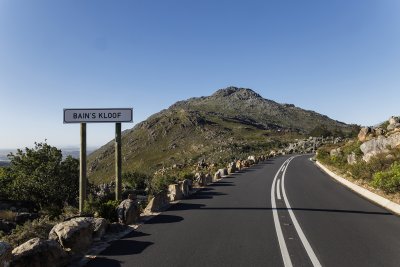

That said, JLR also wins because they've kept physical buttons in the car. Raising and lowering the suspension, changing drive mode, and adjusting the climate controls are easy while on the go without taking your eyes off the road for more than a passing glance.
As much as the interior appointments are a standout for the Defender, the tester had its fair share of squeaks and rattles, mostly coming from the rear cargo area where we had stored some luggage during the day, but not enough to strain the space. And, the luggage wasn't rubbing on anything that would cause it to make the noises.
After some time winding our way along Bain's Kloof Pass into Ceres, South Africa, it was overtly apparent that the Defended OCTA is wide. The narrow lanes on the mountain made the right-hand drive Defender feel even bigger to those of us that traditionally sit on the left side to steer.
After a coffee shop stop where we were warned to be on the lookout for pesky baboons who like the "invade" the space when the door is left open, we were back on the road and headed north toward the Cederberg Mountains.
A quick left turn onto a dirt road and within a mile we were in the rough. Heavy dust kicked up from the convoy, slowing the pace. Off-road drive modes were engaged.
Though the pace was plodding at times, we ticked along at relatively high speed with the OCTA's suspension working to minimize impact to passengers as we passed vast wilderness that ran into an oasis on repeat until we started into the mountains.
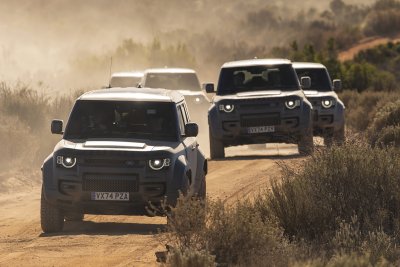
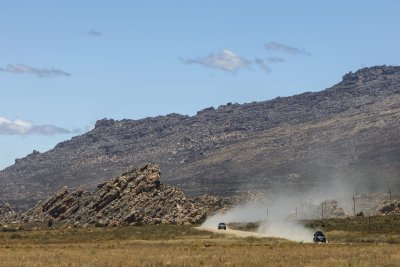
The group lunched at Mount Ceder, watching a herd of goats frolic in the heat in their pastoral landscape that led to massive, slanted steeps in the distance.
The convoy of OCTAs set off to climb those mountains, trading pebbled roads for harder tracks in places, and some cement surfaces where runoff was an obvious issue. While OCTA is good in corners at speed on a closed course track, in the real world things got a bit squirrely so slower speeds were needed at those moments. Recovering off of a slow down, the OCTA's transmission sometimes stumbled to find a gear, with it eventually kicking to the right spot and allowing the throttle press proper attention.
Eventually the road disappeared into more rugged tracks like you'd find in Johnson Valley, California, but with less sand. Bones of animals that were less fortunate when making the journey dotted the landscape alongside the brush. Everything was covered in a thick layer of yellow and orange-tinted dust, drivers and passengers included.
Several hours later, past lands dotted with fields of rooibos, we wound our way down into Wupperthal, a small town that has, since the early 1800s, made traditional South African farm shoes, Veldskoen, that have gained popularity throughout the world.
Then it was onto the Pakhuis Pass, a road with more paving than previous passageways, but dotted with reminders of semi-primitive life. Lone power poles connected remote villages to each other and the grid, and children played in the river, stopping to stare as we paraded through, getting rewarded for their interest with sweets we gave out.
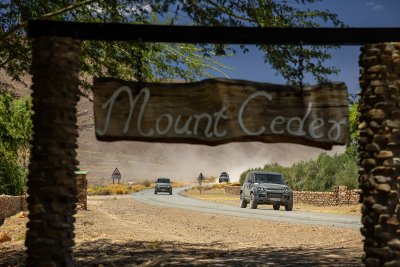
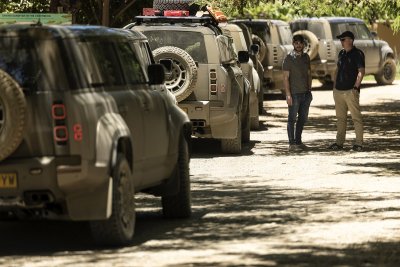
Driving on, we neared the property line of Bushman's Kloof Wilderness Reserve, a 7,500-hectare private reserve where mountains meet oasis and unforgiving terrain is around nearly every turn. We tested the SUVs on craggy rock outcroppings where it was spectacular, before finally reaching the night's lodgings and a much-needed shower.
The next morning we were up with the sunrise catching views of antelope lounging on the lawn before setting off on another full day of adventuring. It started with more rock climbing, where the only downside was the small camera view on the infotainment screen showing the sides of the vehicle. Despite its size, it was helpful.
Leaving the reserve we popped out on paved, smooth roads to make our way to the coast. Ascending and descending mountain roads at a clip showed that OCTA isn't just happy off-roading. Its twin-turbocharged V8 engine offered its 626 horsepower and 553 pound-feet of torque without hesitation, eating up the road and allowing for more dynamic steering than a traditional SUV would ever ensure, all while keeping its occupants stable and comfortable. It was spectacular.
About an hour later we reached Lambert's Bay, where Defender had rented out "The Dunes" as it's labeled on Google Maps, an ancient lake bed that has long since dried up leaving spectacular hills of fine-grain sand alongside the Jakkalsrivier.

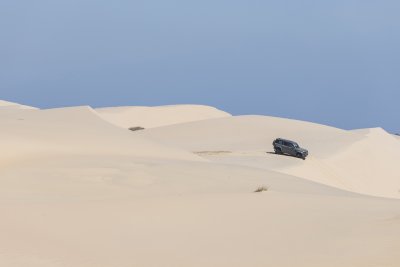
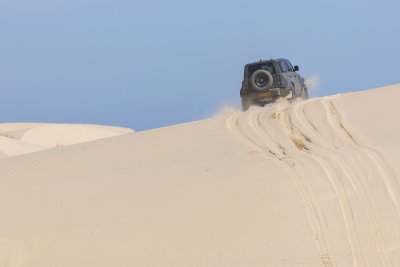
JLR's driving pros had set up a route in the dunes that was a couple of kilometers long and incorporated blind hills and curves, all to be taken at relatively high speed. After airing down the tires, we set off, throwing sand in our wake, remarking to others in the group just how easy it was to traverse the landscape. Driving in dunes is always an adventure. Add in speed and reliable prowess and it's even better.
After that, we high-tailed it another few hours on the pavement, googling what South African speed cameras look like along the way. There's a delightfully quaint chaos to rural road traffic in the Western Cape where rules and lines only matter some of time, it seems, from the way locals drive.
Arriving in Stellenbosch, we stopped for very late lunch at Eight Feet Village, perched on the side of Bothmanskloof Pass. The restaurant served up exquisite dishes without pretense. We ate overlooking vineyards and olive groves, such abundance that it was hard to not be thankful for the plenty we all had in front of us after seeing the villages we had driven through earlier in the trip.
During the days-long journey, we piloted $153,000 Defender OCTAs across some of the world's most adventure-ready terrain; saw zebras, antelope and baboons in their natural habitat; listened to a chorus of seals play in the sunshine and witnessed the rustic lifestyles that exist within Africa's wilderness. OCTA's impressive technology, mechanics and appointments ensured that all happened in style, ease and comfort.
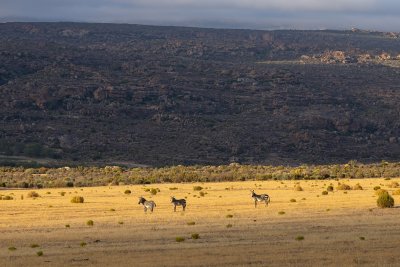
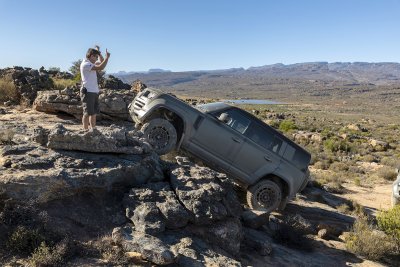
For extreme off-roading, there's no vehicle on the market today that can outpace Defender OCTA. If you want one as a parking lot princess status symbol you also won't be disappointed. There are few compromises with the Defender unless you wish it was less of a fuel sipper, was offered as a battery-electric vehicle, or had more upmarket differentiation styling.
Defender isn't just back. It has its street and off-road credentials firmly in place. The future is much more fun because of it.
About the writer
Eileen Falkenberg-Hull leads the Autos team at Newsweek. She has written extensively about the auto industry for U.S. News & ... Read more



